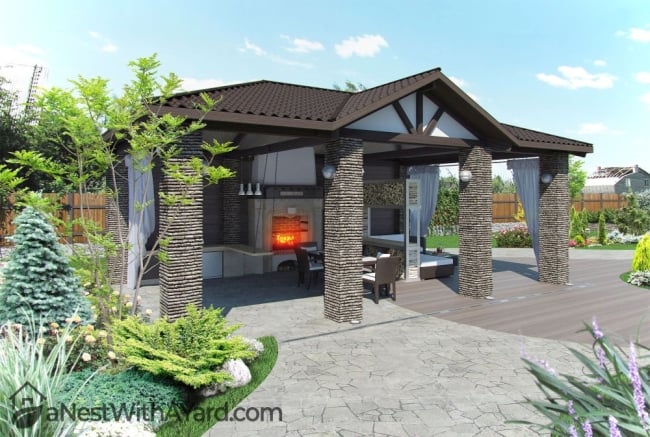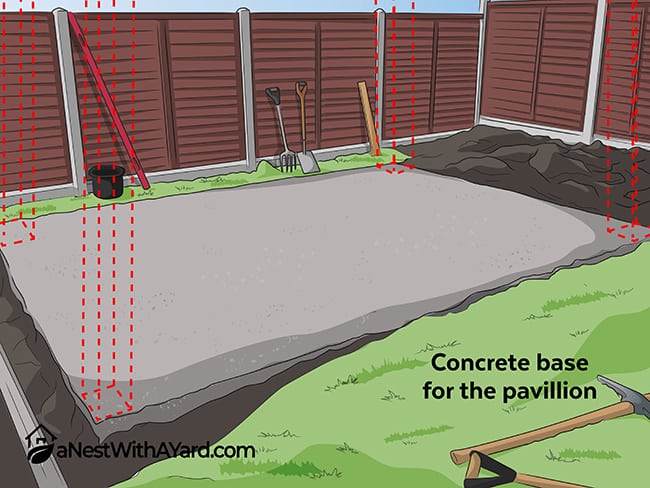Imagine being able to enjoy your morning cup of coffee under a gazebo or pavilion while looking forward to the rest of the day. This is not a farfetched dream since more and more people are upgrading their backyards with either of these structures.
But which one is better for you? A gazebo vs pavilion?
If you would like a shade structure in the middle of your backyard, opt for a gazebo. Conversely, if you would like to upgrade your porch, invest in a pavilion.
In this article, I will explain in detail which backyard structure is best for which situation.
Contents
Review: What Is A Gazebo?
A gazebo is a type of pavilion. More precisely, it is an outdoor shade structure that resembles a traditional room space with the benefits of being outdoors. Their hexagonal, octagonal or oval shape makes them unique and easy to spot.
You have probably come across one in a public park since they are a great socializing spot where people can meet. So, why not bring this cozy place to your backyard?
Before you do that, let’s take a look at some of the features of a gazebo or read our whole article about what a gazebo is.
The Design
While all gazebos do not look the same, they all have a standard design. They have a roof, flooring and partly open sides.
Traditional railing and balusters make gazebos more enclosed than pavilions. The semi-open design creates offers more privacy. And, if that is not enough, you can always screen-in the sides.
The most recognizable design feature of a gazebo is its shape. Traditional gazebos have a hexagonal, octagonal, or oval shape, while hardtop and pop-up gazebos are mostly square, similar to pavilions.
If the traditional design of a gazebo does not suit you, you can always put your creativity to use and customize it. Companies like Fifthroom specialize in custom gazebo designs.

Flooring And Roofing
Compared to pavilions, gazebos are known for having their own decking. Because of this feature, they can be built in the middle of a yard. They can also be mounted on a concrete base and attached to your garden wall.
Gazebos have a fully enclosed roof that offers protection from the sun and rain. The roof is domed and supported by strong pillars. Traditional gazebos have hexagonal or octagonal roof lines that complement the overall shape of the structure.
If you choose to buy a stationary gazebo, you can expect your roof to be made of asphalt shingles. If you are interested in a portable gazebo, the roof will be a replaceable canopy roof made of fabric.
Materials
Just like pavilions, gazebos can be made of different materials, each with its own pros and cons. Hardwood, like treated pine or cedar, offers sturdiness and durability, which will ensure the longevity of your gazebo.
If you are a handy person who possesses the basic knowledge of construction, consider buying a DIY wooden gazebo kit sold online or in home improvement stores.
Other materials used to build gazebos include brick, stone, vinyl, aluminum, wrought iron, and canvas, to name a few. Portable gazebos are typically made with a metal frame and have either a metal roof (hardtop) or a canvas one (soft-top).

Placement
Pavilion vs gazebo? Which one better fits your backyard?
Gazebos are pretty versatile and forgiving when it comes to placement. They can be attached to a wall, but they shine the most when they are placed in the middle of a lawn, overlooking a great view. You may need to attach it to the ground so that it won’t get blown by strong winds.
Pavilions, on the other hand, act the best as an extension of the house.
Gazebo Pros
- Instantly add value to your home
- Have their own flooring, allowing for freestanding placement in the middle of your lawn
- Partly closed design protects from outdoor elements, like sun and rain
- Offers more privacy than a pavilion
- You can safely run electricity to a gazebo
- Allows for the installation of insect screens
Gazebo Cons
- Expensive to build
- Can make your backyard look crowded or chopped up if not placed strategically
- The enclosed design may prevent you from enjoying the summer breeze
- Hardwood frame requires repainting and staining
- Holds fewer people than a pavilion
Review: What Is A Pavilion?
A pavilion is an outdoor shade structure that resembles a house without walls. Its simple design offers a shelter with all the perks of the outside world.
The simplicity of its design is what makes it versatile and easy to fit into any backyard or patio. Let’s take a closer look at a pavilion’s design.
The Design
A pavilion has a simpler design compared to a gazebo. The biggest difference lies in its completely open sides. The absence of a railing creates an integrated environment that is completely welcoming.
A pavilion has a full roof, which is supported by a minimum of four posts. The typical shape of a pavilion is square or rectangular, but it can also be L or T-shaped.
The overall design of a pavilion is more forgiving than that of a gazebo. It can accommodate more luxury features, such as an outdoor kitchen, a fireplace, sofas, and outdoor lounge, chairs to name a few.

Flooring And Roofing
Unlike a gazebo, a pavilion has no built-in floor. For this reason, you will find pavilions mostly near the home on a concrete or stone patio.
The roof of a pavilion is fully enclosed, offering protection from the sun and rain. The roof is sloped and can be in a triangular or pyramid shape.
You can make your patio pop by choosing a pavilion with a double roof, instead of a single roof. If you’re looking for some inspiration, check out Fifthroom.
Materials
The materials used for building a pavilion are the same as for a gazebo. Hardwood is the traditional choice. Exposed cedar or pine beams and rafters will add a rustic feel.
Vinyl pavilions, on the other hand, come in many colors and do not require repainting and refinishing, as wood does. However, you will have to power wash it every now and then.
Last but not least, consider how climate will affect the material of your pavilion. Metal, brick, and stone are best for humid weather, while exposed metal and fabric are suitable in drier climates.

Placement
Pavilions are not as independent as gazebos since they do not have a built-in floor. They are usually attached to the house somehow and are less often seen freestanding in the middle of the backyard.
If you would like to extend your deck or upgrade your paver patio opt for a pavilion since they are easier to integrate than a gazebo. Pavilions are usually larger than gazebos, so consider this when deciding upon final placement.
Pavilion Pros
- Instantly adds value to your home
- Can be made out of different materials to accommodate your budget
- Versatile design can easily be integrated into your home
- Open design without sides does not look bulky or out of place
- Offers more room to hold larger groups of people
- Can accommodate an outdoor kitchen, fireplace, sofas, and other custom features
Pavilion Cons
- Expensive to build
- No built-in floor
- Take over a large area of your backyard
- Hardwood frame requires repainting and refinishing
- Does not offer privacy like a gazebo
Gazebo Vs Pavilion: Features Face To Face
A gazebo and pavilion are quite similar to each other. But when examined closely, you will see that each structure has one or two superior features. Let’s compare them face to face.
Size
Pavilions are generally bigger than gazebos and they can hold larger groups of people. The open design with no sides can accommodate more luxury features, as well. You can upgrade your pavilion with a large sofa, a picnic table, a grill, or even an outdoor kitchen.
Backyard gazebos, unlike commercial ones, are smaller and cozier. The semi-closed design will limit your options for furnishings.
The pavilion is the clear winner in this instance because its size makes it more accommodating to people and furniture.
Resistance To Outdoor Elements
Gazebos are more resistant to outdoor elements because of their semi-closed design. While both backyard structures offer dense shade, rain is more likely to penetrate a pavilion because it has no sides.
Because of this, running electricity to a gazebo is usually safer. It is also easier to install curtains or screens into a gazebo, which will shelter you from wind and insects.
The gazebo is the clear winner for people who live in an area with diverse weather.
Cost
A gazebo can cost you anywhere from a couple of hundred dollars for a pop-up type to more than $12,000 for a large hardwood or vinyl gazebo. Additional luxury features, like a pathway, steps, built-in benches, and electrical wiring will up the cost.
According to HomeAdvisor, building a gazebo will cost you just above $6,281. Pre-built structures range anywhere from $1,500 to $7,000.
Pavilions are typically more expensive than gazebos. However, the total cost will truly depend on the size, shape, and, of course, any additional upgrades.
The cost of a pavilion will significantly increase if you decide to build it in the middle of your backyard instead of on your patio. Remember, pavilions do not have a built-in floor, so you will have to install a concrete base, which can cost anywhere from $2,800 to $6,300.
In this case, the clear winner is the gazebo since it will not cost you as much.

Conclusion: Consider Your Needs
It is safe to say that a gazebo or pavilion will add value and style to your home. If you are still not sure about the winner of the “gazebo vs pavilion” debate, take your needs and desires into consideration.
Invest in a gazebo if:
- You would like a shade structure in the middle of your yard
- You do not intend to host large groups of people
- You would like more privacy from family and neighbors
- You live in an area where it is not always sunny
- You would like to keep insects out
- You want a romantic and cozy ambiance
Invest in a pavilion if:
- You would like to have a shady spot on your patio
- You have a large family
- You would like to lounge on a big sofa next to your outdoor grill
- You live in a drier climate
- You would like to fully experience the freedom of being outside
- You have an unused concrete base
If you wonder how a gazebo differs from other outdoor structures, read this post about Gazebo vs Pergola.
This is a good article Re the pros and cons and differences. I found the article because I found myself not remembering the word gazebo. My father showed me one once that his company had built for a customer. I said it was too ornate. It was only much later in life I was told he’d designed it.